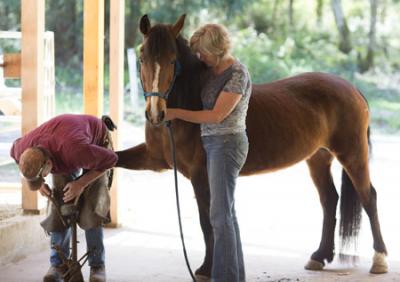
The Farrier of Vashon Island

Tom Wallace gently taps the back of Bella’s leg, asking permission to lift her hoof so that he can remove her worn shoe and replace it with a new one. Rebecca, Tom’s wife, cradles Bella’s head and speaks reassuringly to her, keeping her calm and making her feel safe in an uncomfortable moment. Bella is one of four horses in the Wallace stable, now her herd, and she calls out to two who romp in the pasture without her.
Bella is a bit spooky, having had a difficult early life. Possibly a mustang, she was bound for slaughter when Tom and Rebecca bought her instead. She was slow to gentle, refusing human contact for many weeks until she decided that Rebecca was a friend, and on that day she approached Rebecca in the pasture, laid her big brown head on Rebecca’s shoulder and surrendered. They were instantly created friends for life.
Tom shows a master’s grasp of the technical, anatomical and psychological minutia of horses and their metal footwear that comes with his 25 years of experience. Formerly an engineer, he speaks with an articulate intensity in a soft, confident voice, passionately describing the vast detail of his craft and his four-footed clientele. He constantly reassures Bella that she is safe, and when she twitches, he seems to see it coming in advance.
The horse evolved from a three-toed ancestor. Only vestigial anatomical elements remain of the two outer toes, while the center toe became today’s horse’s hoof. The hard outer part is a type of thick toenail and it is that part that holds the shoe. Since the nails don’t penetrate flesh, the horse doesn’t feel any pain when the shoe is nailed on. The horseshoe protects the horse’s foot just like our shoes protect our feet. It provides a tough surface on the bottom of the hoof to improve traction and to take the extra force of a rider.
Caesar’s Romans shoed their horses with leather and metal shoes and by the 6th century European equestrians nailed bronze shoes to their horses feet. The term "farrier" comes from the Latin word for iron, and in the middle ages most blacksmiths were also farriers. That’s no longer true, though, and today the two trades are separate.
Tom says that horseshoes normally last about 6 weeks, so the one or two hour pedicure that 18-year-old Bella got today is something she’s experienced many times before. Tom starts with Bella’s left front hoof. He removes the worn shoe with a specialized tool and drops it in a handy bucket. The wall of the hoof has continued to grow since the last time Bella was shod, so he uses a special knife and a large clipper to remove some of the extra tissue. He inspects the hoof bottom to make sure everything is still healthy, then levels the hoof with a rasp.
Next, he fits a new shoe, shaping it on his anvil with a hammer to make it fit the exact shape of Bella’s hoof. Farriers can make their own shoes out of bar stock, but it’s cheaper and quicker to use manufactured shoes. When the shoe fits, Tom heats it red hot in his forge and does some extra shaping with hammer and firmer, then while it is still glowing he uses a shoe holder and presses it to the bottom of Bella’s hoof sealing the tissue against moisture. Char marks indicate exactly where hoof and shoe still don’t meet, and Tom fine tunes the fit with his rasp.
Purpose-shaped horseshoe nails affix shoe to hoof, and those are clinched to hold the shoe in place until it is worn and needs replacing. Tom files down any protruding nail bits and a final coat of a urethane sealer helps prevent moisture intrusion.
Horses have been shod for twenty centuries or so and most equestrians and horse owners keep their horses shod. The Mongols followed Genghis Khan in the 13th century, fighting on the backs of shod horses, and conquered most of Asia including China and India. The Comanche Indians who were the hegemonic power until 1871 in what is now Nebraska, Colorado, Oklahoma and Texas did not shoe theirs. Comanches also fought on horseback, raiding as far as 300 miles from their camps and they often loaded captives – always women or children – on the backs of their own horses for the lightening trip home.
Any human activity breeds controversy, and thus it is with the shoeing of horses. The "Barefoot Horse" movement is a group of horse aficionados who believe that it is better to keep horses unshod. Tom thinks that probably works better for horses that live on drier ground than we have here in the Pacific Northwest. He and Rebecca tried to keep their horses unshod for a time but found it difficult for their horses to work comfortably that way, so except for the older horse who is retired, they keep them shod now.
Bella never complained while getting her new shoes, but when it was over she did seem relieved. Rebecca led her out of the barn and into the corral where they demonstrated her one trick, stepping onto a large stump with her front legs, placing her head high into the air. Big smiles all around.
Biffle French is a Vashon artist, writer and the National Rodeo Correspondent for The Vashon Loop. Look for his new book "American Rodeo."
- Login to post comments
